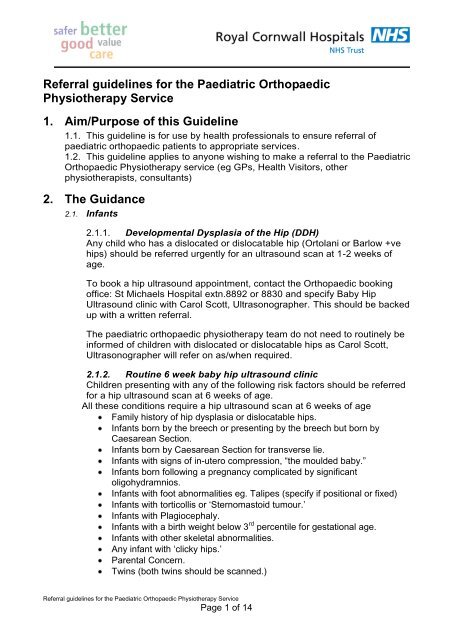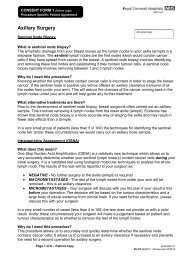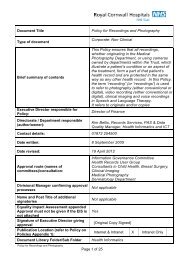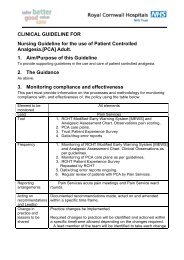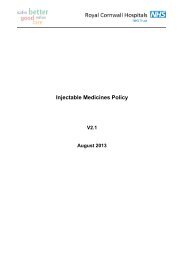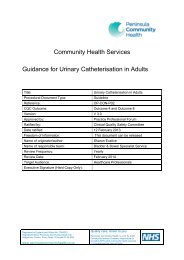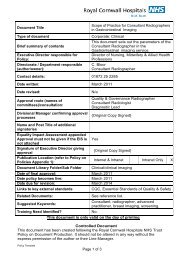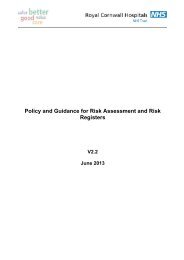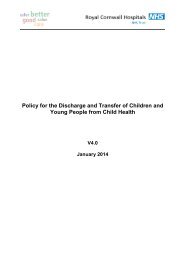Referral guidelines for the Paediatric Orthopaedic Physiotherapy ...
Referral guidelines for the Paediatric Orthopaedic Physiotherapy ...
Referral guidelines for the Paediatric Orthopaedic Physiotherapy ...
You also want an ePaper? Increase the reach of your titles
YUMPU automatically turns print PDFs into web optimized ePapers that Google loves.
To book a hip ultrasound send a written referral to <strong>the</strong> <strong>Orthopaedic</strong> bookingoffice, St Michaels Hospital Hayle,: extn 8892 or 8830 and specify Carol Scottsbaby hip ultrasound clinic.2.1.3. Fixed/Congenital Talipes Equinovarus (CTEV)Any child with fixed talipes equinovarus should be referred urgently to <strong>the</strong><strong>Paediatric</strong> <strong>Orthopaedic</strong> Physio<strong>the</strong>rapy team. Contact paediatric orthopaedicphysio<strong>the</strong>rapy admin, St Michaels Hospital extn 8846 Mon-Fri. A writtenreferral will also be required.The child will not always be seen by a physio<strong>the</strong>rapist on <strong>the</strong> ward but <strong>the</strong>ywill be offered an outpatient appointment within 1 week. If CTEV isdiagnosed antenatally through a scan, <strong>the</strong> parents may already be known to<strong>the</strong> <strong>Paediatric</strong> <strong>Orthopaedic</strong> Physio<strong>the</strong>rapy team. Please notify <strong>the</strong> teamwhen <strong>the</strong> child is born.Mr Parsons does not need to routinely be in<strong>for</strong>med of babies with fixedtalipes or o<strong>the</strong>r congenital foot problems as <strong>the</strong> paediatric orthopaedicphysio<strong>the</strong>rapy team will refer on as necessary.2.1.4. Obstetric Brachial Plexus PalsyA child presenting with a brachial plexus palsy should be referred urgently to<strong>the</strong> <strong>Paediatric</strong> <strong>Orthopaedic</strong> Physio<strong>the</strong>rapy team. Contact orthopaedicpaediatric physio<strong>the</strong>rapy admin, St Michaels Hospital extn 8846. A writtenreferral will also be required. The child will not always be seen by aphysio<strong>the</strong>rapist on <strong>the</strong> ward but <strong>the</strong>y will be offered an outpatientappointment within 1 week. An X-ray of clavicles is required to excludefractures.Upper limb Consultant <strong>Orthopaedic</strong> Surgeon RCHT does not need toroutinely be in<strong>for</strong>med of new babies with Obstetric Brachial Plexus Palsy as<strong>the</strong> <strong>Paediatric</strong> <strong>Orthopaedic</strong> Physio<strong>the</strong>rapy team will refer on as necessary.2.1.5. Upper Limb Abnormalities<strong>Referral</strong> to Consultant <strong>Orthopaedic</strong> Surgeon via referral managementservice2.1.6. Lower Limb DeficienciesRefer directly to Dr Rachel Bottell, Disablement Services Centre, Derri<strong>for</strong>dHospital, Tel 0845 155 80732.1.7. Positional De<strong>for</strong>mities of <strong>the</strong> feetFor a child who presents with positional de<strong>for</strong>mities e.g. Positional talipesequinovarus, calcaneovalgus, metatarsus adductus, Make a written referralto <strong>the</strong> <strong>Paediatric</strong> <strong>Orthopaedic</strong> Physio<strong>the</strong>rapy team via <strong>Referral</strong> ManagementService2.1.8. PlagiocephalyRefer as soon as identified to <strong>the</strong> <strong>Paediatric</strong> <strong>Orthopaedic</strong> Physio<strong>the</strong>rapyTeam via <strong>Referral</strong> Management Service2.1.9. TorticollisRefer as soon as identified to <strong>the</strong> <strong>Paediatric</strong> <strong>Orthopaedic</strong> Physio<strong>the</strong>rapyTeam via <strong>Referral</strong> Management Service.<strong>Referral</strong> <strong>guidelines</strong> <strong>for</strong> <strong>the</strong> <strong>Paediatric</strong> <strong>Orthopaedic</strong> Physio<strong>the</strong>rapy ServicePage 2 of 14
2.2.1. Curly Toes /Overlapping Toes“Curly toes” are common in infancy and characterised by flexion andexternal rotation of <strong>the</strong> lesser toes. Most will resolve spontaneously and areasymptomatic 2 . There is no evidence that physio<strong>the</strong>rapy can be used totreat curly toes.Asymptomatic curly toesPain, redness, callous <strong>for</strong>mation,difficulty finding footwear.5 th toe overriding 4 th toes and difficultywith footwearNo treatment requiredDiscuss referral with PCH-CICPodiatry departmentRefer to Ben Holroyd or JamesMetcalfe Consultant <strong>Orthopaedic</strong>Surgeons via <strong>Referral</strong> ManagementService2.2.2. Genu varum / Genu valgumBe<strong>for</strong>e <strong>the</strong> age of two, most children will have slight symmetrical bowing of<strong>the</strong> knees and ankles when <strong>the</strong>y stand. Between <strong>the</strong> ages of two and four,children may develop genu valgum and a standing inter-malleolar distanceof approximately 6 centimeters is considered normal. Genu valgum normallycorrects itself and approximately <strong>the</strong> age of 6 3 .Asymmetrical genu varum / genuvalgumConcerns regarding excessive genuvarum / genu valgumRefer to <strong>Paediatric</strong> <strong>Orthopaedic</strong>Consultant via <strong>Referral</strong>Management ServiceRefer to <strong>Paediatric</strong> <strong>Orthopaedic</strong>Consultant Team via <strong>Referral</strong>Management Service2.2.3. OuttoeingAssess <strong>the</strong> child once walking is well established eg .walkingindependently <strong>for</strong> 6 monthsAsymptomatic symmetrical outtoeing can be a normal variant caused byei<strong>the</strong>r external tibial torsion, proximal femoral retroversion or a combinationof <strong>the</strong> two. Outtoeing may be symptomatic or asymptomatic. There are anumber of differential diagnoses that may present with an outtoeing gait (egPer<strong>the</strong>s, DDH, Slipped upper femoral epiphysis).Sudden onset out toeing followingtrauma (sometimes low level)Asymmetrical out toeingSymmetrical out toeing associatedwith pain in hips, knees or feetSymmetrical out toeingAsymptomaticRefer to A/ERefer to <strong>Orthopaedic</strong> Consultant via<strong>Referral</strong> Management ServiceRefer to paediatric <strong>Orthopaedic</strong>physio<strong>the</strong>rapy team RCHT via<strong>Referral</strong> Management Service<strong>Referral</strong> not required.<strong>Referral</strong> <strong>guidelines</strong> <strong>for</strong> <strong>the</strong> <strong>Paediatric</strong> <strong>Orthopaedic</strong> Physio<strong>the</strong>rapy ServicePage 4 of 14
2.2.4. IntoeingAssess <strong>the</strong> child once walking is well established eg .walkingindependently <strong>for</strong> 6 monthsIntoeing may be due to metatarsus adductus, internal tibial torsion orfemoral anteversion. Children with metatarsus adductus should be referredto <strong>the</strong> paediatric <strong>Orthopaedic</strong> physio<strong>the</strong>rapy team (See table below)Internal tibial torsion is a normal variant up to 7 years of age 4 and may besymmetrical or asymmetrical. Femoral anteversion is a normal variant up to10 years of age 4 and is generally symmetrical.Physio<strong>the</strong>rapy is not indicated <strong>for</strong> asymptomatic normal variants and cannotprevent <strong>the</strong> tripping often associated with intoeing. However <strong>the</strong>re is oftenparental concern <strong>the</strong>re<strong>for</strong>e a leaflet titled “Intoeing Gait” is available via alink on <strong>the</strong> referral management system. The Plymouth <strong>Paediatric</strong><strong>Orthopaedic</strong> Consultant team have also produced a section on <strong>the</strong>ir website(www.pposw.com or www.pposw.co.uk) - regarding normal variants and aleaflet on <strong>the</strong>ir links section.If as a health practitioner you remain concerned please telephone <strong>the</strong><strong>Paediatric</strong> <strong>Orthopaedic</strong> Physio<strong>the</strong>rapy Team to discuss if referral isappropriate. Tel 01872 253824 or contact <strong>the</strong> <strong>Orthopaedic</strong> Physio<strong>the</strong>rapyAdmin Team if no answer (01736 758846)Curved lateral border of <strong>the</strong> foot(Assess by holding a pen/pencil along<strong>the</strong> lateral border)Curved Lateral Border of <strong>the</strong> footindicates Metatarsus adductus.Refer to <strong>the</strong> paediatric <strong>Orthopaedic</strong>physio<strong>the</strong>rapy Team RCHT via<strong>Referral</strong> Management ServiceAsymptomatic intoeing with straightlateral border of <strong>the</strong> foot andsymmetrical hip range of movementAsymmetrical hip rotation orabductionIntoeing associated with foot ,knee orhip painNo treatment required.Parents can be issued with <strong>the</strong> adviceleaflet “Intoeing Gait” available via <strong>the</strong>link on <strong>the</strong> referral managementsystemRefer to Consultant <strong>Orthopaedic</strong>Surgeon via <strong>Referral</strong> ManagementServiceRefer to paediatric <strong>Orthopaedic</strong>Physio<strong>the</strong>rapy Team via RMS<strong>Referral</strong> <strong>guidelines</strong> <strong>for</strong> <strong>the</strong> <strong>Paediatric</strong> <strong>Orthopaedic</strong> Physio<strong>the</strong>rapy ServicePage 5 of 14
2.2.5. Tip toe walkingMany children will tiptoe walk when first starting to weight bear and firststarting to walk. Persistent tiptoe walking, once walking is fully established,may be a symptom of a neurological disorder or may be associated withtight tendo achilles.Assess <strong>the</strong> child once walking is well established eg .walkingindependently <strong>for</strong> 6 monthsAbnormal lower limb neurologyTightness of Tendo Achilles / limitedankle dorsiflexion with normalneurologyNormal NeurologyRefer to Consultant <strong>Paediatric</strong>ianRCHTRefer to <strong>Paediatric</strong> <strong>Orthopaedic</strong>Physio<strong>the</strong>rapy Team via <strong>Referral</strong>Management ServiceRefer to <strong>the</strong> <strong>Paediatric</strong> <strong>Orthopaedic</strong>Physio<strong>the</strong>rapy Team via <strong>Referral</strong>Management Service2.2.6. Back PainThere is an increased likelihood of serious pathology in <strong>the</strong> under-20 yearage group.There are a number of red flags specific to paediatric back pain 5Specific Red Flags in <strong>Paediatric</strong> PopulationHistoryPre-pubertal children especially4 weeksRecurrent or worsening painEarly morning stiffness and/orgellingNight painFever, weight loss, malaisePostural changes: kyphosis orscoliosisExaminationFever, tachycardiaWeight loss, bruisinglymphadenopathy or abdominal massAltered spine shape or mobilityVertebral or intervertebral tendernessLimp or altered gaitNeurologic symptomsChildren presenting with <strong>the</strong>se red flags should be referred to <strong>the</strong> Acute<strong>Paediatric</strong>ian Team, Level 4, Tower Block, Treliske Hospital.(See RCHT Care Pathway <strong>for</strong> <strong>the</strong> Physio<strong>the</strong>rapy Management of <strong>Paediatric</strong>Back Pain)The <strong>Paediatric</strong> <strong>Orthopaedic</strong> Physio<strong>the</strong>rapy team accepts referrals <strong>for</strong>paediatric back pain with <strong>the</strong> absence of red flags under <strong>the</strong> age of 10years. Children over 10 years of age with <strong>the</strong> absence of red flags should bereferred to <strong>the</strong> local musculoskeletal outpatient physio<strong>the</strong>rapy department.2.3. A summary of <strong>the</strong>se referral <strong>guidelines</strong> is at Appendix 1<strong>Referral</strong> <strong>guidelines</strong> <strong>for</strong> <strong>the</strong> <strong>Paediatric</strong> <strong>Orthopaedic</strong> Physio<strong>the</strong>rapy ServicePage 6 of 14
3. Monitoring compliance and effectivenessElement to bemonitoredLeadToolFrequencyReportingarrangementsActing onrecommendationsand Lead(s)Change inpractice andlessons to besharedAppropriateness of referrals received by <strong>the</strong> multi-disciplinarypaediatric orthopaedic teamClinical Leads, <strong>Paediatric</strong> <strong>Orthopaedic</strong> Physio<strong>the</strong>rapy ServiceCompare each referral received with this guidanceEach referral received will be monitoredPro<strong>for</strong>ma response to be sent to referrer detailing reasons <strong>for</strong>return of referralTherapy Manager (Outpatients) to address persistent noncon<strong>for</strong>mance(if identified) with <strong>the</strong> appropriate line managersRequired changes to practice will be identified and actioned withinone month. A lead member of <strong>the</strong> team will be identified to takeeach change <strong>for</strong>ward where appropriate. Lessons will be sharedwith all <strong>the</strong> relevant stakeholders4. Equality and Diversity4.2. This document complies with <strong>the</strong> Royal Cornwall Hospitals NHS Trustservice Equality and Diversity statement.4.3. Equality Impact AssessmentThe Initial Equality Impact Assessment Screening Form is at Appendix 1.<strong>Referral</strong> <strong>guidelines</strong> <strong>for</strong> <strong>the</strong> <strong>Paediatric</strong> <strong>Orthopaedic</strong> Physio<strong>the</strong>rapy ServicePage 7 of 14
Appendix 1. Summary of <strong>Referral</strong> GuidelinesFlat FeetAble to easily (and bilaterally) go up ontotiptoes (age appropriate)Arch present on tip toeNo tightness on ankle dorsiflexionNormal neurologyNo painful symptomsNo poor function, eg tripping / fallingAbsence of associated syndromeseg.Downs, Marfans, Ehlos Danlos ,hypermobility syndromeAbnormal neurologyArch not present on tip toeAsymmetrical flat footSignificant pain affecting activities of dailylivingTightness on ankle dorsiflexionDifficulty rising onto tip toesMarked tripping / fallingPain in knees or hipsPainful feet in child under 5 years of ageIf child 6 years of age and older and any offollowing:Pain in feet / anklesSkin pressure lesions of feet / anklesExcessive medial shoe wear causing poorfunctionCurly ToesAsymptomatic curly toesPain, redness, callous <strong>for</strong>mation, difficultyfinding footwear.5th toe overlapping 4th toes and difficultywith footwearIn-toeingCurved lateral border of <strong>the</strong> foot(Assess by holding a pen/pencil along <strong>the</strong>lateral border)Asymmetrical hip rotation or abduction with<strong>the</strong> hip at 90 degrees flexionIntoeing associated with foot ,knee or hippainNo treatment required. <strong>Referral</strong> tophysio<strong>the</strong>rapy or podiatry is not appropriate.Consider issuing advice leaflet “flat feet inyoung children” available from <strong>the</strong> link on<strong>the</strong> referral management website.Refer to Consultant <strong>Paediatric</strong>ians RCHTRefer to Consultant <strong>Orthopaedic</strong> Surgeonvia <strong>Referral</strong> Management ServiceRefer to <strong>Paediatric</strong> <strong>Orthopaedic</strong>Physio<strong>the</strong>rapist RCHT via <strong>Referral</strong>Management ServiceRefer to <strong>the</strong> Podiatry DepartmentPCH-CICNo treatment requiredDiscuss referral with PCH-CIC PodiatrydepartmentRefer to Consultant <strong>Orthopaedic</strong> Surgeonvia <strong>Referral</strong> Management ServiceCurved Lateral Border of <strong>the</strong> foot indicatesMetatarsus adductus.Refer to <strong>the</strong> paediatric <strong>Orthopaedic</strong>physio<strong>the</strong>rapy Team RCHT via <strong>Referral</strong>Management ServiceRefer to Consultant <strong>Paediatric</strong> <strong>Orthopaedic</strong>Surgeon via <strong>Referral</strong> ManagementServiceRefer to <strong>Paediatric</strong> <strong>Orthopaedic</strong>Physio<strong>the</strong>rapy Team via <strong>Referral</strong>Management Service<strong>Referral</strong> <strong>guidelines</strong> <strong>for</strong> <strong>the</strong> <strong>Paediatric</strong> <strong>Orthopaedic</strong> Physio<strong>the</strong>rapy ServicePage 8 of 14
Out toeingAsymmetrical out toeingSymmetrical out toeing associated with painin hips, knees or feetNormal NeurologyTip-toe WalkingAbnormal lower limb neurologyTightness of Tendo Achilles / limited ankledorsiflexion with normal neurologyNormal NeurologyBack Pain<strong>Paediatric</strong> Specific Red flags presentAbsence of red flags(Age under 10 years)Absence of red flags(Age over 10 years)Refer to <strong>Paediatric</strong> <strong>Orthopaedic</strong> Consultantvia <strong>Referral</strong> Management ServiceRefer to paediatric <strong>Orthopaedic</strong>physio<strong>the</strong>rapy team via <strong>Referral</strong>Management ServiceRefer to <strong>the</strong> <strong>Paediatric</strong> <strong>Orthopaedic</strong>Physio<strong>the</strong>rapy Team via <strong>Referral</strong>Management ServiceRefer to <strong>the</strong> Consultant <strong>Paediatric</strong>iansRCHTRefer to <strong>Paediatric</strong> <strong>Orthopaedic</strong>Physio<strong>the</strong>rapy Team via <strong>Referral</strong>Management ServiceRefer to <strong>the</strong> <strong>Paediatric</strong> <strong>Orthopaedic</strong>Physio<strong>the</strong>rapy Team via <strong>Referral</strong>Management ServiceRefer to Acute Consultant <strong>Paediatric</strong>iansRCHTRefer to <strong>Paediatric</strong> <strong>Orthopaedic</strong>Physio<strong>the</strong>rapy Team via <strong>Referral</strong>Management ServiceRefer to Local Musculoskeletal OutpatientPhysio<strong>the</strong>rapy DepartmentSpecific Red Flags in <strong>Paediatric</strong> Population 5HistoryPre-pubertal children especially4 weeksRecurrent or worsening painEarly morning stiffness and/orgellingNight painFever, weight loss, malaisePostural changes: kyphosis orscoliosisExaminationFever, tachycardiaWeight loss, bruisinglymphadenopathy or abdominal massAltered spine shape or mobilityVertebral or intervertebral tendernessLimp or altered gaitNeurologic symptoms<strong>Referral</strong> <strong>guidelines</strong> <strong>for</strong> <strong>the</strong> <strong>Paediatric</strong> <strong>Orthopaedic</strong> Physio<strong>the</strong>rapy ServicePage 9 of 14
Appendix 2. Governance In<strong>for</strong>mationDocument TitleDate Issued/Approved: 8 August 2013<strong>Referral</strong> <strong>guidelines</strong> <strong>for</strong> <strong>the</strong> <strong>Paediatric</strong><strong>Orthopaedic</strong> Physio<strong>the</strong>rapy ServiceDate Valid From: 8 August 2013Date Valid To: 1 August 2016Directorate / Department responsible(author/owner):Sarah Harvey and Rachel Hancock, ClinicalLead Physio<strong>the</strong>rapistContact details: 01736 758846Brief summary of contentsGuidance <strong>for</strong> those wishing to refer to <strong>the</strong><strong>Paediatric</strong> <strong>Orthopaedic</strong> Physio<strong>the</strong>rapyServiceSuggested Keywords:Target AudienceExecutive Director responsible <strong>for</strong>Policy:<strong>Referral</strong> <strong>guidelines</strong> <strong>for</strong> <strong>the</strong> <strong>Paediatric</strong> <strong>Orthopaedic</strong> Physio<strong>the</strong>rapy ServicePage 10 of 14<strong>Paediatric</strong> orthopaedics, intoeing, outtoeing,flexible flat feet, normal variants, genuvarum, genu valgumRCHT PCH CFT KCCGMedical DirectorDate revised: 1 August 2013This document replaces (exact title ofprevious version):Approval route (names ofcommittees)/consultation:Divisional Manager confirmingapproval processesName and Post Title of additionalsignatoriesSignature of Executive Director givingapprovalPublication Location (refer to Policyon Policies – Approvals andRatification):Document Library Folder/Sub Folder<strong>Referral</strong> <strong>guidelines</strong> <strong>for</strong> <strong>the</strong> <strong>Paediatric</strong><strong>Orthopaedic</strong> Physio<strong>the</strong>rapy ServiceAHP Therapies Clinical Governance Forum<strong>Paediatric</strong> <strong>Orthopaedic</strong>s Consultants atRCHT and Plymouth Hospitals NHS Trust(Derri<strong>for</strong>d)Consultant <strong>Paediatric</strong>ians RCHTPodiatry Department PCH-CICBruce Daniel, Interim Divisional ManagerD&TSally Rowe, Divisional Director D&TNot Applicable{Original Copy Signed}Internet & IntranetClinical / Physio<strong>the</strong>rapy Intranet Only
Links to key external standardsRelated Documents:Training Need Identified?National Service Framework <strong>for</strong> Children,Young People & Maternity ServicesCare Quality Commission Outcome 4 – Care& Welfare of People who use serviceso Guidelines <strong>for</strong> <strong>the</strong> referral of <strong>Paediatric</strong>Back Pain to <strong>the</strong> Physio<strong>the</strong>rapy Serviceo Association of <strong>Paediatric</strong> CharteredPhysio<strong>the</strong>rapists (APCP) Guide toGood Practice <strong>for</strong> Physio<strong>the</strong>rapistsWorking with Childreno APCP Advice Publications – “Flat Feetin Young Children” and “Intoeing Gait”(June 2011)o Department of Health publication - Birthto Five (2009) – Chapter 4 “How YourChild will Grow”o See also Reference List at Appendix 3NoVersion Control TableDateVersionNoSummary of ChangesChanges Made by(Name and Job Title)20 Oct 11 V1.0 Initial Issue14 Oct 12 V2.0Alteration of Consultant names to generic<strong>Orthopaedic</strong> consultant. Alteration of referralpathway to paediatric orthopaedicphysio<strong>the</strong>rapy (now via <strong>Referral</strong> ManagementService).Addition re routine hip scans.Alteration to curly toes 5th overlapping 4th.Addition to outoeing referral criteria re traumaInsertion of picture of lateral border of footUnder intoeing sectionSarah HarveyAll or part of this document can be released under <strong>the</strong> Freedom of In<strong>for</strong>mationAct 2000This document is to be retained <strong>for</strong> 10 years from <strong>the</strong> date of expiry.This document is only valid on <strong>the</strong> day of printingControlled DocumentThis document has been created following <strong>the</strong> Royal Cornwall Hospitals NHS TrustPolicy on Document Production. It should not be altered in any way without <strong>the</strong>express permission of <strong>the</strong> author or <strong>the</strong>ir Line Manager.<strong>Referral</strong> <strong>guidelines</strong> <strong>for</strong> <strong>the</strong> <strong>Paediatric</strong> <strong>Orthopaedic</strong> Physio<strong>the</strong>rapy ServicePage 11 of 14
Appendix 3.Initial Equality Impact Assessment Screening FormName of service, strategy, guideline, policy or project (hereafter referred to as policy)to be assessed: <strong>Referral</strong> <strong>guidelines</strong> <strong>for</strong> <strong>the</strong> <strong>Paediatric</strong> <strong>Orthopaedic</strong> Physio<strong>the</strong>rapyServiceDirectorate and service area: Diagnostics Is this a new or existing Procedure? New& Therapeutics Division, AHP Therapies,Physio<strong>the</strong>rapyName of individual completingTelephone: 01872 253824assessment: Sarah Harvey1. Procedure Aim* Minimise inappropriate referrals to <strong>the</strong> <strong>Paediatric</strong><strong>Orthopaedic</strong> Physio<strong>the</strong>rapy Service2. Procedure Objectives* Ensure patients are seen by <strong>the</strong> most appropriate clinicalservice3. Procedure – intended Reduced incidence of inappropriate referralsOutcomes*4. How will you measure Analysis of referrals received<strong>the</strong> outcome?5. Who is intended to <strong>Paediatric</strong> orthopaedic patientsbenefit from <strong>the</strong>Procedure?6a. Is consultationrequired with <strong>the</strong>work<strong>for</strong>ce, equalitygroups etc. around thisprocedure?b. If yes, have <strong>the</strong>segroups been consulted?c. Please list any groupswho have been consultedabout this procedure.No*Please see Glossary7. The ImpactPlease complete <strong>the</strong> following table using ticks. You should refer to <strong>the</strong> EA guidance notes<strong>for</strong> areas of possible impact and also <strong>the</strong> Glossary if needed.Where you think that <strong>the</strong> policy could have a positive impact on any of <strong>the</strong> equalitygroup(s) like promoting equality and equal opportunities or improving relationswithin equality groups, tick <strong>the</strong> ‘Positive impact’ box.Where you think that <strong>the</strong> policy could have a negative impact on any of <strong>the</strong> equalitygroup(s) i.e. it could disadvantage <strong>the</strong>m, tick <strong>the</strong> ‘Negative impact’ box.Where you think that <strong>the</strong> policy has no impact on any of <strong>the</strong> equality group(s) listedbelow i.e. it has no effect currently on equality groups, tick <strong>the</strong> ‘No impact’ box.<strong>Referral</strong> <strong>guidelines</strong> <strong>for</strong> <strong>the</strong> <strong>Paediatric</strong> <strong>Orthopaedic</strong> Physio<strong>the</strong>rapy ServicePage 12 of 14
Equality Positive Negative No Reasons <strong>for</strong> decisionGroup Impact Impact ImpactAge Improved care <strong>for</strong> paediatricpatientsDisabilityReligion orbeliefGenderTransgenderPregnancy/MaternityRaceSexualOrientationMarriage / CivilPartnershipYou will need to continue to a full Equality Impact Assessment if <strong>the</strong> following havebeen highlighted:A negative impact andNo consultation (this excludes any policies which have been identified as notrequiring consultation).8. If <strong>the</strong>re is no evidence that <strong>the</strong> policypromotes equality, equal opportunitiesor improved relations - could it beadapted so that it does? How?Full statement of commitment to policy ofequal opportunities is included in <strong>the</strong> policyPlease sign and date this <strong>for</strong>m.Keep one copy and send a copy to Matron, Equality, Diversity and Human Rights,c/o Royal Cornwall Hospitals NHS Trust, Human Resources Department, ChyveanHouse, Penventinnie Lane, Truro, Cornwall, TR1 3LJA summary of <strong>the</strong> results will be published on <strong>the</strong> Trust’s web site.Signed ________________________________________Date _________________________________________<strong>Referral</strong> <strong>guidelines</strong> <strong>for</strong> <strong>the</strong> <strong>Paediatric</strong> <strong>Orthopaedic</strong> Physio<strong>the</strong>rapy ServicePage 13 of 14
Appendix 4. References1 Cappello T, Song KM (1998) ‘Determining treatment of flat feet in children’, CurrentOpinion in Pediatrics, vol 10, pp 77-812 Staheli L (1989) Fundamentals of Pediatric <strong>Orthopaedic</strong>s, 3 rd Edition, London: LippincottWilliams & Wilkins3 Fabry G, Cheng LX, Molenaers G (1994) ‘Normal and Abnormal Torsional Developmentin Children’, Clinical <strong>Orthopaedic</strong>s and Related Research, Number 302, pp 22-264 Staheli L (1983) ‘Intoeing and Outtoeing in Children’, The Journal of Family Practice, Vol16, no 5, pp 1005-10115 Davis PJC, Williams HJ (2008) ‘The investigation and management of back pain inchildren’, Arch Dis Child Educ Pract Ed, vol 93, pp 73-83<strong>Referral</strong> <strong>guidelines</strong> <strong>for</strong> <strong>the</strong> <strong>Paediatric</strong> <strong>Orthopaedic</strong> Physio<strong>the</strong>rapy ServicePage 14 of 14


